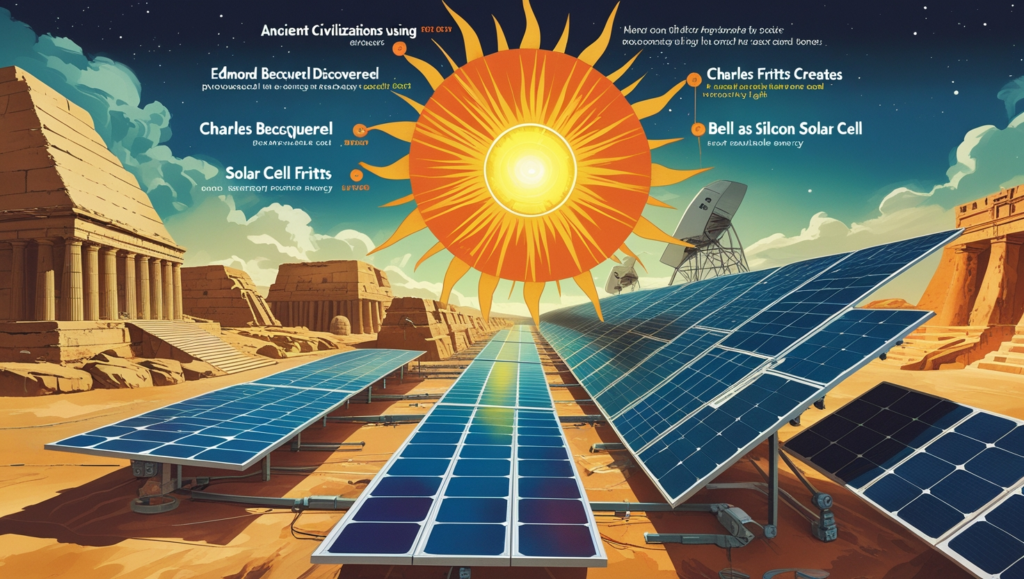Solar energy, while often viewed as a modern innovation, has roots that stretch back centuries. Its journey from early scientific discoveries to a transformative global technology is a testament to human ingenuity and our drive for sustainable solutions.
In this article, you’ll learn about the key milestones in the history of solar power, starting from its earliest conceptualization to its remarkable presence in today’s energy landscape. Understanding this timeline not only highlights the brilliance of past innovators but also underscores the importance of solar energy in shaping a cleaner, greener future.

Early Discoveries: The Roots of Solar Energy
The journey of solar energy began long before the invention of modern solar panels. Early civilizations recognized the sun’s immense power and found ways to harness it for practical purposes:
- Ancient Civilizations and Passive Solar Design
Early societies, including the Greeks, Romans, and Chinese, demonstrated remarkable ingenuity in their use of solar energy. They designed buildings to maximize sunlight for heating and illumination. For example, Roman bathhouses often featured large south-facing windows to capture the sun’s warmth during colder months. - The Magnifying Glass (7th Century BCE)
Ancient Greeks took the concept further by using magnifying glasses to concentrate sunlight. This focused energy was powerful enough to ignite fires—a simple but effective early application of solar power.
These early innovations showcase humanity’s long-standing curiosity about and reliance on the sun. Though primitive by today’s standards, these practices laid the foundation for the development of advanced solar technologies.
The First Solar Invention: Photovoltaics in the 19th Century
The transition from harnessing the sun’s heat to generating electricity marked a pivotal moment in the history of solar energy. This shift began with the groundbreaking work in photovoltaic technology during the 19th century:
- Edmond Becquerel’s Discovery (1839)
French physicist Edmond Becquerel uncovered the photovoltaic effect, a phenomenon where sunlight generates an electric current in certain materials. His experiments with an electrolytic cell demonstrated that light could produce energy, laying the scientific groundwork for solar electricity. - Charles Fritts and the First Solar Cell (1883)
In 1883, American inventor Charles Fritts built the first functional solar cell using selenium coated with a thin layer of gold. Although its efficiency was less than 1%, this invention represented a significant leap forward. It proved that sunlight could be directly converted into electricity, paving the way for modern solar panels.
These early milestones in photovoltaic technology marked the beginning of a new era for solar energy, transforming it from a concept into a functional source of power.

The Birth of Modern Solar Energy
The 20th century marked a turning point for solar energy, with advancements that made it a practical and reliable source of power. Two key milestones stand out:
- Bell Labs’ Silicon Solar Cell (1954)
Bell Laboratories revolutionized solar technology by creating the first practical silicon solar cell with an efficiency of 6%. This innovation introduced the use of silicon, a material still central to today’s solar panels. The Bell Labs cell demonstrated that solar power could efficiently generate electricity, paving the way for the commercial solar industry. - NASA’s Use of Solar Energy (1958)
The potential of solar energy reached new heights when NASA utilized solar cells to power the Vanguard 1 satellite. This successful deployment highlighted the reliability and durability of solar energy in extreme environments, inspiring further innovations for both space and terrestrial applications.
These advancements set the stage for solar energy’s global adoption, showcasing its versatility and practicality for diverse uses.
Solar Energy in the 21st Century
In the 21st century, solar energy has solidified its role as a key component of the global shift toward renewable energy. Advancements in technology and growing environmental awareness have driven its rapid adoption.
- Efficiency Improvements
Modern solar panels have come a long way since their early iterations. With efficiencies now reaching up to 22%, these panels can convert more sunlight into electricity, making solar energy more cost-effective and accessible for residential, commercial, and industrial use. Research into next-generation materials like perovskite promises even greater efficiency in the near future. - Global Adoption
Solar energy has transitioned from a niche solution to a mainstream power source. Governments, businesses, and homeowners are turning to solar to reduce reliance on fossil fuels and combat climate change. Massive solar farms, such as those in China, the United States, and India, generate gigawatts of electricity, while residential solar installations empower individuals to produce their own clean energy.
The 21st century represents a tipping point for solar energy, demonstrating its potential to transform the global energy landscape and create a sustainable future.

Why Understanding Solar History Matters
Exploring the history of solar energy offers more than just a glimpse into technological progress—it provides valuable insights into humanity’s journey toward a sustainable future.
- Appreciation for Innovation
By understanding the milestones in solar energy’s development, from ancient passive solar techniques to modern photovoltaic breakthroughs, you can truly appreciate the ingenuity that has shaped this transformative technology. - Inspiration for Sustainability
Solar energy’s history showcases humanity’s ability to adapt and innovate in the face of environmental challenges. It serves as a reminder that investing in renewable energy solutions is critical for creating a cleaner, greener planet. - Guidance for the Future
Learning about the evolution of solar power helps you recognize its potential to address today’s energy challenges. The lessons from past innovations can inspire continued advancements and encourage widespread adoption.
Understanding solar energy’s story underscores its importance in reducing reliance on non-renewable resources and highlights its pivotal role in shaping a sustainable, energy-secure future.
Be Part of the Solar Revolution
Solar energy isn’t just a milestone in human history—it’s a catalyst for a sustainable future. By embracing solar solutions, you’re not only reducing your carbon footprint but also becoming part of a global effort to preserve our planet.
- Join the Legacy of Innovation
From its ancient roots to modern advancements, solar energy reflects humanity’s drive to innovate for a better tomorrow. By adopting solar power, you’re continuing this legacy. - Empower a Brighter Future
Switching to solar isn’t just an environmental choice; it’s an investment in energy independence, economic savings, and global sustainability.
Are you ready to take the next step? Explore the top solar energy solutions available today and become a pioneer in the solar revolution. Let’s build a cleaner, greener world together—starting now!










2 thoughts on “When Solar Energy Was Invented”
Comments are closed.